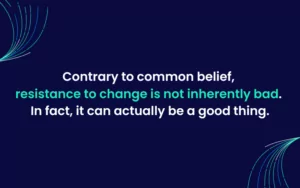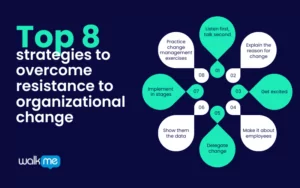Chloe loves the new brand of coffee in the office kitchen. Steve is thrilled with the new project management software, and the sales team is pumped about the new boss. Change is smooth.
Sound familiar? No, probably not.
People rarely accept change so easily. That’s because resistance to change is a natural human instinct.
This creates a serious problem for businesses. In today’s market, change is critical to success. Organizations cannot survive if they are slow to innovate and lack business agility. But this inevitably means a lot of people going through a lot of change.
That’s why effectively mitigating resistance to change is a critical skill for change management.
This guide will help you overcome employee resistance to ensure your change initiatives succeed.
Dive Deeper: 4 Barriers to Organizational Change

What is resistance to change?
To put it simply, change is scary — and challenging. Maintaining an existing habit is easier than changing. Trying something new means there is a possibility of failure. Most people prefer to stay in their comfort zone than venture into unknown territory.
Even individuals who claim to enjoy change may find it challenging in the workplace. After all, choosing to make a change in one’s personal life is very different from accepting top-down organizational change. Resistance to change in the workplace occurs because most often employees don’t have a choice. This triggers a sense of lost control and uncertainty.
Imagine organization-wide new software implementation. As an employee, you are competent using the old platform, and don’t necessarily understand the need for a new system. What you do understand is: This will require effort to relearn basic functions. Consciously or subconsciously, you might fear that the change will hurt your job performance.
Too often, employees focus on what may be lost, rather than what can be gained.
Who resists change?
While there is a misconception that change only affects low-level employees, this is not the case. The change affects everyone in an organization from maintenance to upper management. Additionally, resistance has nothing to do with intelligence. Not even the smartest among us are not immune to the scariness of impending changes.
Why does resistance occur?

We have identified what resistance to change is, and who is likely to resist change, but we haven’t identified reasons why it occurs.
The first and possibly most obvious reason is that people are scared of the unknown, which is to be expected since change and uncertainty are a package deal. This is a natural human reaction outside of the workplace, but within an organization, the fear of the unknown can mean job uncertainty and unpredictability. As the saying goes, “If it ain’t broke, don’t fix it,” and so employees who can’t understand the reason for the change will see it as some form of threat to their job security and therefore, resist it.
Similarly, the feeling of a loss of control will invite resistance among employees. If they feel that whatever changes that are taking place are forced upon them, they will resist it. Ensuring there is two-way communication between change managers and employees will encourage a feeling of buy-in and let them know that not only do their opinions matter but that they are “in-the-know”.
On the flip side, poor communication will likely cause resistance to change. If employees don’t feel part of the process or don’t think that they are being updated or included on a project’s progress, then they will either resist the change or become indifferent towards it.
Neither of these reactions is desirable during a change initiative as you need cooperation at every level. If the change process is communicated effectively and employees understand not just why the change is happening, but also how it will improve their day-to-day, they will not feel a need to resist it.
Finally, we are all creatures of our experience. If employees have had bad experiences when it comes to organizational change, they will project those fears onto the current change. Change managers have to be careful and listen to the experiences of employees to make sure similar mistakes aren’t repeated. When employees feel their voices are being heard they will be more receptive to change and less likely to resist.
How to identify resistance to change
Resistance to change can manifest itself in several different ways. It could come in the form of missed deadlines, failed commitments, being absent from meetings, and a general sense of apathy are all indicating signs that employees are not invested in the organization.
Resistance to change could also present itself in more obvious ways. When change is occurring, pay attention to your employee’s general mood, whether there is more gossip than usual, or if they are responding to requests in a sarcastic or snide manner.
In some cases, there may be an individual elected by the employees to speak out against the change. This may be in the form of an official union or just a collection of individuals who share the same feelings towards the change and see that there is power in numbers.
This representative will not only be a mouthpiece for the employees and will also be a channel of communication for management. Such individuals should be utilized by the management to filter positive information about the change to the group to help combat these signs of resistance.
The surprising benefits of resisting change
Contrary to common belief, resistance to change is not inherently bad. In fact, it can actually be a good thing.
First, it forces management to choose their battles carefully. Employee pushback begs the question, “Is this change going to drive significant growth?” In other words, is this worth it? This helps ensure resources aren’t thrown into initiatives that don’t have a clear payoff.
Second, it encourages planning and communication. Management must identify where resistance will likely occur and come in with a game plan to prevent it.
So, now that we are a little less frightened of and resistant to change, let’s explore how to best manage employees during organizational change.
Effective change management is all about understanding what underlies resistance to change. From there, you can address your employees’ biggest concerns.
Top 8 strategies to overcome unproductive resistance to change
-
Listen first, talk second
The first strategy to overcome resistance to change is to communicate. Communication is key — you already knew that. However, try letting your employees initiate the conversation. People want to be heard, and giving them a chance to voice their opinions will help alleviate the frustration they feel over the situation.
What’s more, your employee’s thoughts, concerns and suggestions will prove wildly valuable to steer your change project. At the very least, understanding them will help you pinpoint the root of employee resistance to change.
-
Communicate the reasons for change
The next strategy to overcome resistance to change is to communicate the why, what and how. Develop a communication plan that is more than just telling your employees what you want them to do. Effective communication segments and targets each audience, focusing on what they care about and need to know. Underline why this change will benefit them.
-
Get excited
How you communicate the change has a huge impact on how much resistance to change will occur. If you wholeheartedly communicate the reasons for change, your conviction will be contagious. Any hesitancy will undermine the operation.
-
Make it about employees
Change is only possible if your human resources are on board, so make sure changes are approached in terms of the employee. If you are implementing a new software system — plan your project through the lens of user adoption rather than focusing on the technology. It’s not about what the technology can do, it is about what the user can do with the help of this new technology.
-
Delegate change
A great strategy to overcome resistance to change is: Fight resistance with culture. Train team members who are natural leaders first. They will serve as role models and influencers for the rest of your employees. This has a ripple effect.
-
Show them the data
While resistance to change is usually emotional rather than logical, it can be helpful to use some hard facts as a supplementary strategy. Let your employees see the data for themselves. This is a great way to simultaneously show transparency and demonstrate the need for improvement.
You can also leverage AI for change management, the integration of AI-driven tools can significantly streamline the change management process. AI can analyze employee feedback in real-time, predict resistance hotspots, and suggest personalized interventions.
By automating routine tasks and providing data-driven insights, AI empowers leaders to make informed decisions, enhancing the overall effectiveness of change initiatives
-
Implement in stages
Whether digital or other, any kind of transformation can’t just happen overnight. There had to be proper preparation leading up to the change, with plenty of advance warning and participation from employees at all levels. Implementing the plan in stages will employees are able to tackle the change one step at a time, learning the new and relevant skills as they go.
This is a much easier way to digest the change and will feel less drastic for those learning new skills and information, meaning they are less likely to resist the changes at hand.
-
Practice change management exercises
Resistance to change is usually driven by emotions such as fear and feeling threatened. To help combat this there are a number of simple exercises employees can do to simulate the feeling of change. These exercises, which include folding your arms one way and then switching them around or bouncing balls to show companies “bounce back” are also just a bit of fun and are non-threatening unlike genuine change can be. The point of these exercises is to show that though change may be uncomfortable at first, you get used to the new reality pretty quickly.
Overcoming resistance to change
When you use the right strategy, it is entirely possible to effectively overcome resistance to change. By using the strategies above, you can help your employees to see the value in change and make the transition smoother for everyone involved.


